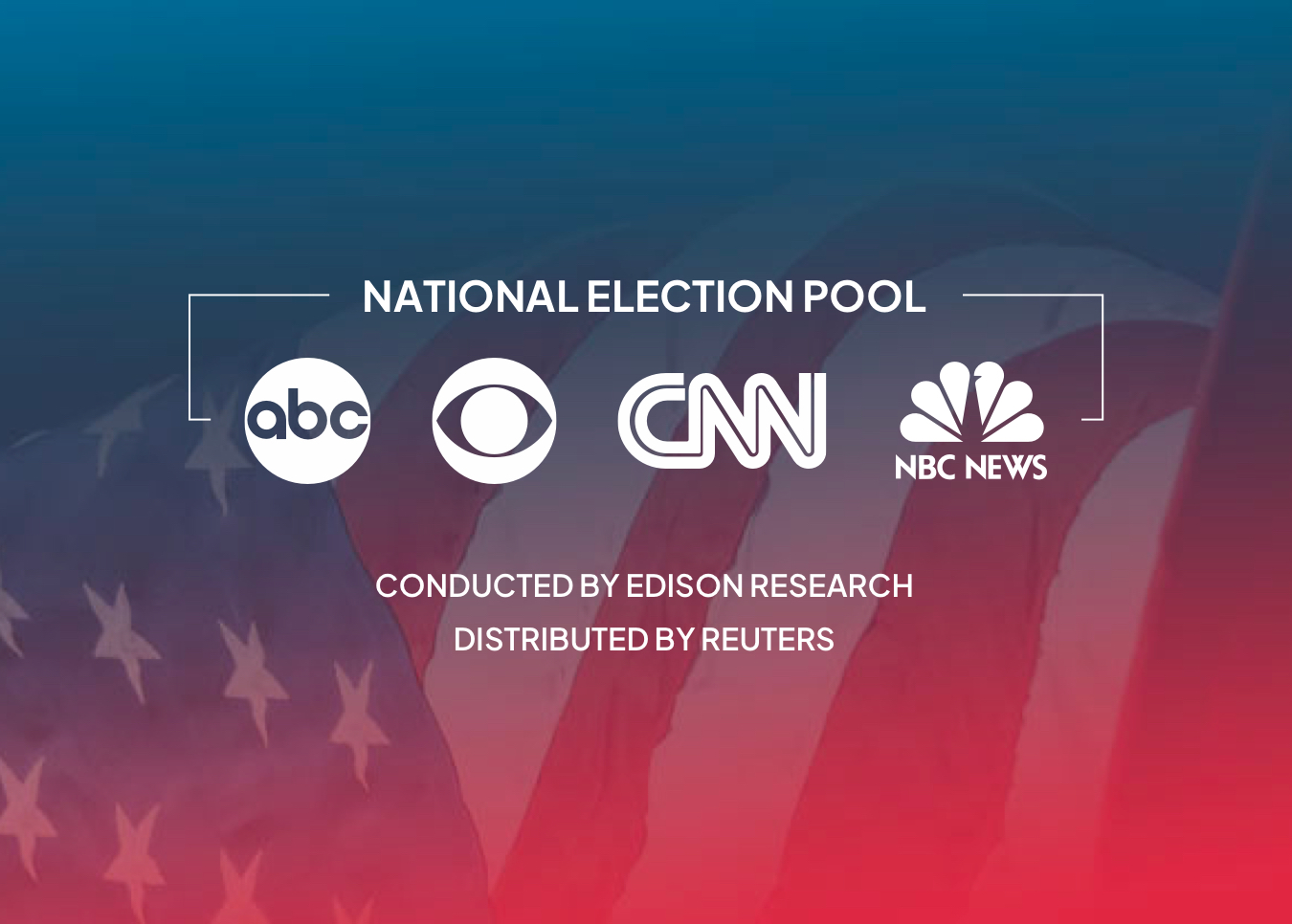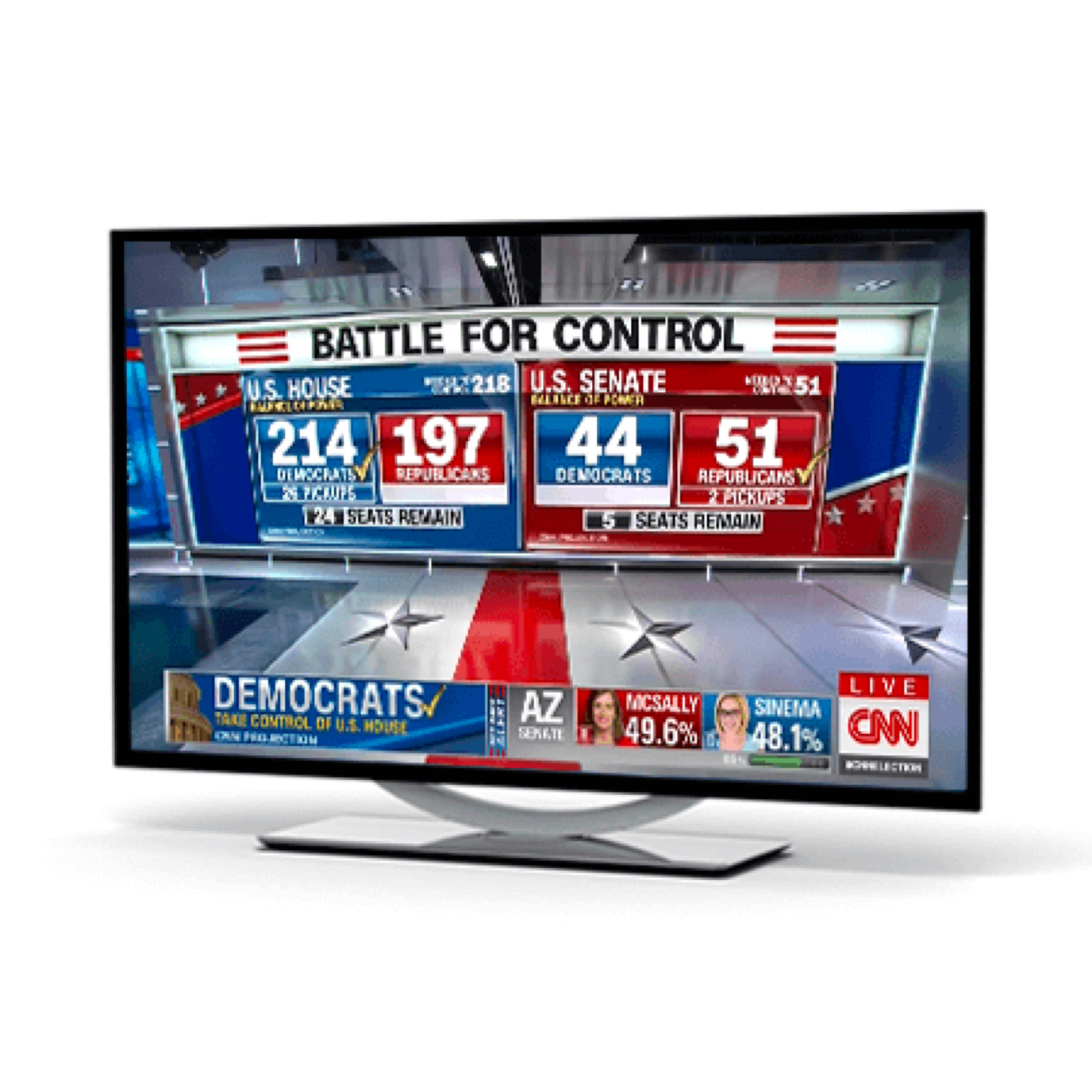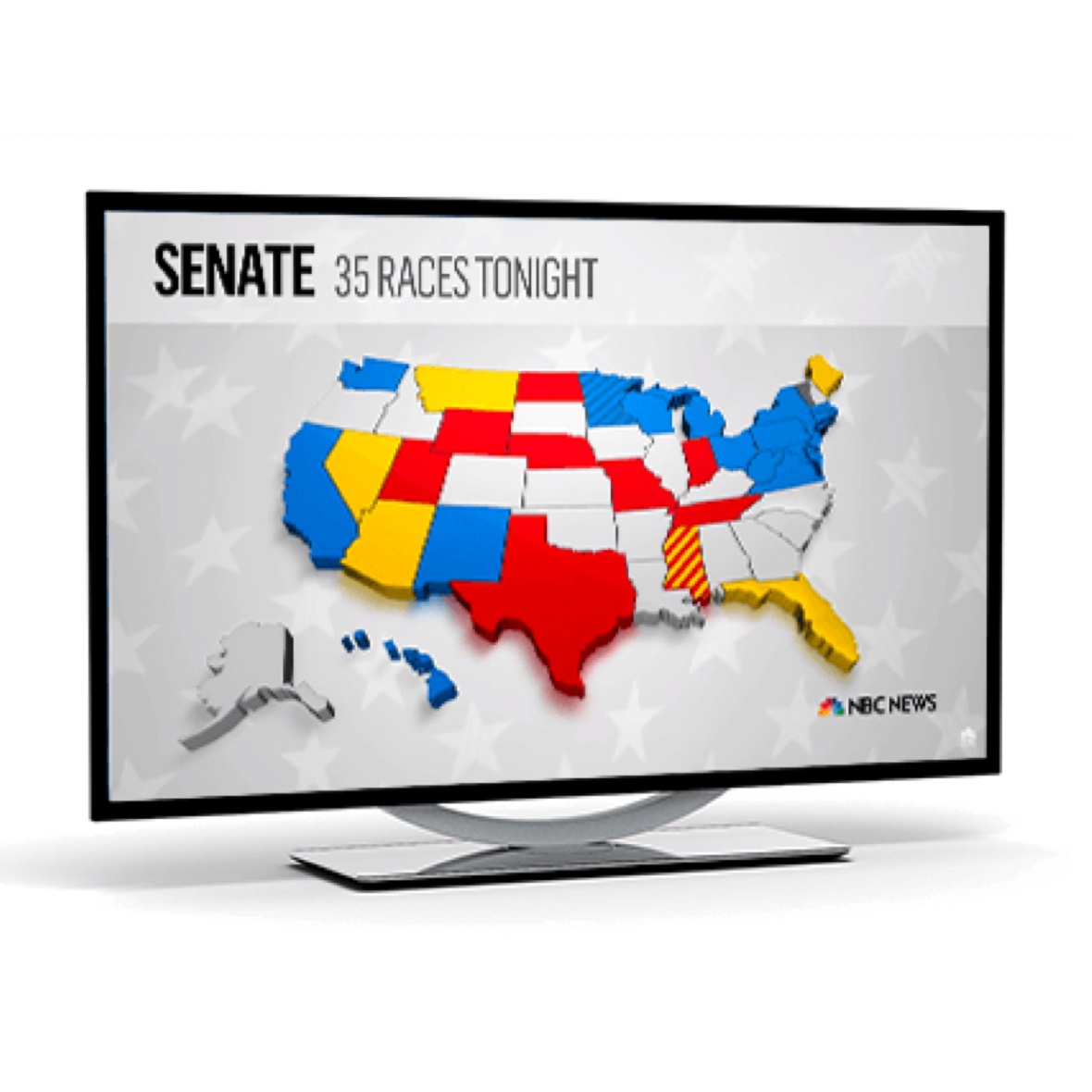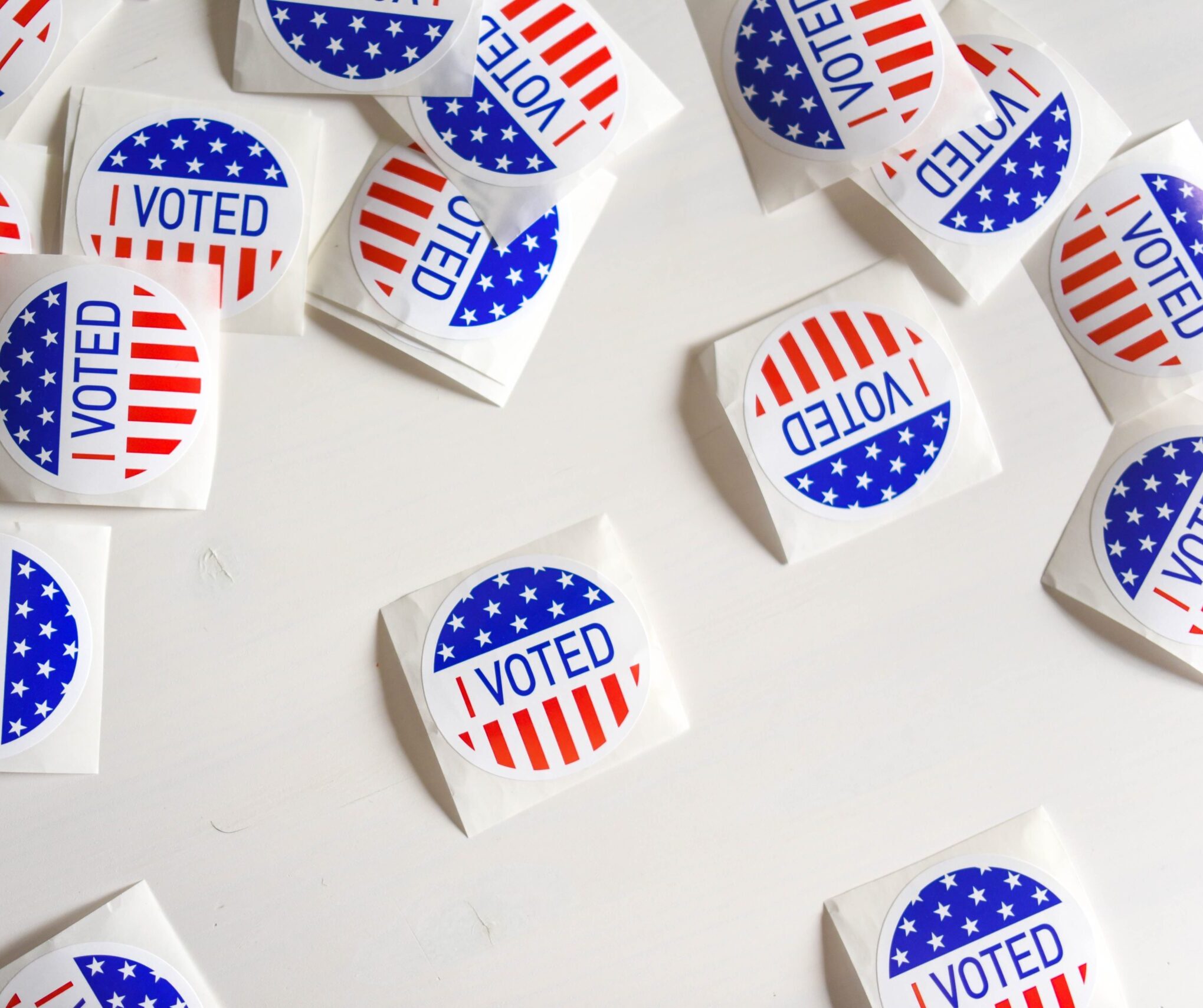Election Day Coverage
Election Day Coverage
The definitive source for accurate, timely and comprehensive election data: Exit Polls, Vote Count, Election Projections

The survey of record for U.S. elections
Since 2004, The National Election Pool (NEP) and Edison Research have conducted the only national exit polls in the United States. The NEP is the source for projections and analysis for every midterm election, presidential primary, and presidential election. Our 2024 election coverage includes Election Day exit polls at voting locations around the country, in-person exit polls at early voting locations, and multi-mode (phone and web) RBS surveys of by-mail voters.
Access our gold standard of data, exclusively through Reuters
Edison Research and the National Election Pool are partnering with Reuters to distribute 2024 General Election to subscribers around the world.
Reuters offers tailored U.S. Election Coverage Packages, including a data-only package, graphics package, and a journalism package. Clients can access data through the National Election Pool API and user-friendly customer web-based application.

In an effort to improve quality, streamline data collection, and expand election coverage in 2018, ABC News, CBS News, CNN, and NBC News ended their arrangement with the Associated Press for vote tabulation and now exclusively partner with Edison Research for these data.
Edison Research provides the NEP with a fast and accurate vote count throughout the nation, delivering data for all statewide races and all House races. Race projections are made in all 50 states for statewide races and ballot measures, as well as all 435 House races.
The fastest and most complete results
The NEP relies on multiple sources for data and a team of the most experienced election experts to provide faster and more accurate data.
NEP vs. AP House Calls 2022: 296 called first by the NEP, 73 by the AP
More data and faster results means timely projections and analysis
Edison’s combination of Election Day exit polls along with early and by-mail voter surveys provides a preview of the important stories on Election Night, and early poll results are available to subscribers at 5pm Eastern, delivering an accurate picture of the key stories of Election Night. At 5pm on Election Night in 2022, Edison’s estimate of the national House popular vote was 51% for the Republicans and 48% for the Democrats. This estimate exactly matched the final margin of 3 points (50.6% to 47.8%).

Exit polls are surveys based on interviews with voters as they exit their balloting locations. Exit polls gather voters’ demographic information, feelings on various issues, and for whom they voted. Since not everyone votes in person on Election Day, the exit poll is now a multi-mode survey – exit poll surveys are conducted in person with early voters and Election Day voters and telephone, e-mail and text surveys are conducted with by-mail and early voters.
Voting in the U.S is anonymous. Without surveying voters in some way, only a small amount of information is known about the makeup of the electorate. Without surveys, the only data that would be gathered during an election is the number of votes received by each candidate and eventually which individual voters turned out to vote. Surveys provide insight into how members of different parties, demographic groups, and supporters of particular candidates voted, and why. Exit polls are a dependable way to conduct interviews with actual voters.
Edison Research was founded in 1994, so the company has been doing exit polls for 28 years. Edison has a contract with the National Election Pool through 2024, so Edison will have conducted exit polling for over 21 years with the NEP. Since 2017, Edison Research has been reporting the vote count, the exit surveys, and the precinct models for U.S. elections.
Exit polls are conducted via different methods (modes) to reach people who vote in different ways:
1. By-mail voters – reached by a multi-mode telephone, email and text survey of registered voters
2. In-person early voters — interviewers are stationed at early voting centers around the country to conduct in-person surveys with voters right after they cast their ballots
3. In-person on Election Day voters — interviewers are stationed outside polling places on Election Day to conduct in-person surveys with voters right after they cast their ballots
In 2020 70% of the presidential election vote was early or by mail and in 2022 slightly more than half of all votes nationwide were cast early or by mail. We have adjusted our methods to reach all voters regardless of which method they use to cast their vote. Our current expectation is that slightly more than half of all votes in 2024 will be cast before Election Day.
Yes. There is no way to link answers on an exit poll to individual voters. Voters complete their in-person exit poll surveys with paper and pencil with no self-identifying information.
No exit poll data that characterizes the outcome of a race is released until all polls close in that state on election night. Any data you see before election night is NOT exit poll data. Once exit poll data is released when the polls close on election night, it is then up to the media outlet as to how they report the findings.
Those results are from pre-election opinion polls, not exit polls. Many media outlets conduct pre-election polling and many pre-election polls predict which candidate is leading going into an election. Pre-election polls measure how people say they are going upcoming election, but those respondents may or may not end up voting. Exit polls measure behavior and views of actual voters.
Edison hires hundreds of exit poll interviewers across the country to collect the data on Election Day and we have several hundred phone operators taking in the data during Election Day so that we can process the tens of thousands of questionnaires that are filled out by voters quickly for use by our clients on election night.
Edison reports the exit poll results in three waves during the day. The first wave includes all early voter interviews and morning interview on Election Day. The second wave adds the midday interviews and shortly before poll closing the third wave adds the afternoon and evening interviews. The initial results of the exit poll surveys are shared with a very limited number of survey analysts within each news organization until after 5PM ET on election day when it is shared throughout the news organization. No exit polls results which can be used to characterize the winner of the election are published before all of the polls in that state are closed.
The exit poll questionnaires typically have about 20 questions and takes most voters about five minutes to fill out.
Edison Research interviewed over 100,000 voters in the 2020 general election. For presidential general elections or midterm elections, Edison Research has people at over 500 Election Day precinct locations. In 2020, we also had interviewers at 200 early voting centers around the country. We interviewed about 30,000 people by telephone before Election Day to identify by mail and early voters.
Between exit poll interviewers and county vote count reporters, Edison Research will hire over 2,000 people to work for us on Election Day.
For voters reached by telephone, it is a telephone interview. For voters reached in person, it is a self-administered paper survey. For voters reached by email or text it is a self-administered online survey.
A committee of polling directors at the news organizations of the NEP writes the questionnaires, and three of the four members have to agree to put a question into the questionnaire. There is usually consensus. The real issue is that there is a limited amount of space on a self-administered questionnaire. Typically, it is a 5.5 x 8.5 piece of paper and usually fits 18–20 questions.
Edison Research has always measured refusals by gender, age, and race. The response rate for these groups is known and we adjust for it. Warren Mitofsky discovered in the late 1960s that there would be differential response rates by demographic characteristics that interviewers could observe. Age is the main issue. Older people, for example, are less likely to take the exit poll questionnaire. We adjust for that. Over the years, we have found differences by education levels in response rates, with college-educated voters being more likely to fill out the exit poll than non-college-educated voters. That difference has become much more partisan. Democrats have done better with college-educated voters, Republicans with non-college-educated ones. We have evaluated these differences and compared them to the Census surveys, and we have added adjustments. Surveys are going to adapt because no mode is perfect, but by combining multiple modes, you have a better chance of eliminating biases in any one.
Using a variety of modes helps combat non-response. Younger people are more likely to respond to text, older people are more likely to respond to telephone, and middle-aged people are more likely to respond to email.
(from Joe Lenski’s interview with AEI) “I’m optimistic polling in general still works. As much as our work in 2004, 2016, and 2020 has taken hits for specific errors in specific states and races, the overall average error in surveys is less than it was decades ago. The real issue is educating about the kind of precision you can and can’t demand from these data. The average errors in 1996 were larger than they have been in more recent elections. But Bill Clinton was winning by a landslide, so it didn’t matter. Now we have races decided by 1 or 2 percentage points. Surveys were never designed for that kind of precision. We live in a time where national elections or crucial elections like the Georgia runoff are decided by small margins. There are several things going on. There is a real problem contacting a representative sample. Then there is the trust issue, and then you have really close elections that decide the Electoral College and control of the Senate and House. But we can still tell the story about Trump doing better than expected among Hispanics in certain places. We told the story of the growing cleavage between White college-educated voters and White noncollege-educated voters. We told the story of red states becoming redder and blue becoming bluer. I don’t see 2022 or 2024 being that different.”
Portions of this FAQ were taken from an interview with Edison Research Co-Founder and Executive Vice President Joe Lenski as part of an article from AEI, American Enterprise Institute. For the full interview and more in-depth information about exit polls: https://www.aei.org/wp-content/uploads/2022/01/The-Exit-Polls.pdf?x91208
